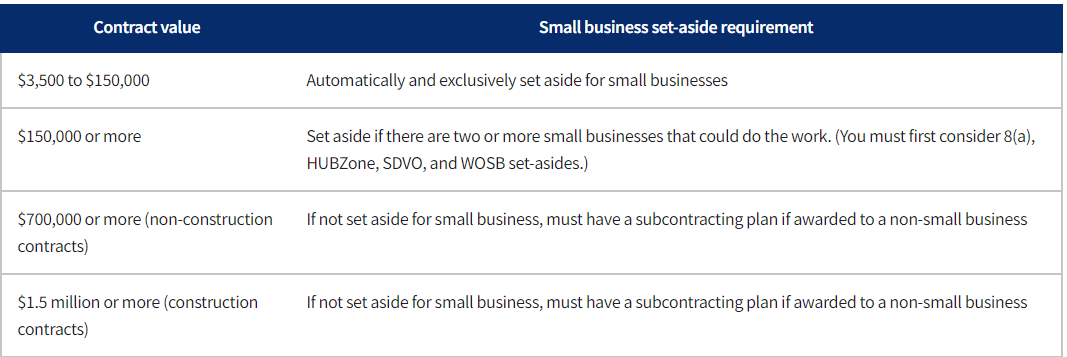What is a GSA Subcontractor?
GSA Schedule | Government Business Development | 5 Min Read
Becoming a government contractor can be daunting for small businesses without enough experience to meet the complex requirements. However, subcontracting is one way small businesses can get their hands on federal government dollars and gain performance experience in the industry. To help government agencies meet their small business spending budgets each fiscal year, large or often referred to as Other than Small Businesses (OTSBs) are required to make a Subcontracting Plan. This plan outlines how an OTSB intends to accomplish its subcontracting goals. As a result, small businesses have a chance to test their ability to perform in the federal marketplace by subcontracting with companies that have a GSA Multiple Award Schedule (MAS). This blog is an overview of GSA subcontracting and explains how small businesses can use subcontracting as a steppingstone toward getting their own GSA contract.
Prime Contractor vs. Subcontractor
Before we begin, what’s the difference between a prime contractor and a subcontractor? Most prime contractors use subcontractors to fulfill a function in a contract that requires specialized talent and to fulfill their subcontracting goals. One of the main differences between a prime contractor and subcontractor is a subcontractor supplies products and/or services to a prime contractor while the prime contractor has a direct contract with the federal government. While subcontractors are involved in the contract, they are not corresponding directly with the government. The prime contractor’s duty is to ensure the project stays within the agency’s desired budget and deadlines are met. On the other hand, subcontractors focus solely on the job they are fulfilling.
What is a GSA Subcontractor?
You may have heard of the term “subcontractor” before, but what does it mean in the context of GSA? GSA subcontractors are small businesses that can sell to the government by partnering with a prime GSA Schedule contractor. As mentioned above, companies that are considered Other than Small Businesses (OTSBs) under their primary NACIS Code are required to submit a Subcontracting Plan that details how they plan to subcontract a portion of their work to small businesses. Small businesses can take advantage of this and find prime contractors to team up with through their GSA Schedules.
Advantages of Becoming a Subcontractor
Becoming a subcontractor lends multiple advantages to small businesses. Subcontracting is an opportunity to work with multiple clients while determining your own project timelines. It’s also a way to build a resume of experience in the federal marketplace and establish relationships with industry experts. A subcontractor is not obligated to carry the brunt of the contract work since the prime contractor holds the GSA Schedule. The subcontractor is only responsible for carrying out the portion of the project assigned by the prime contractor. The completion of the entire project rest on the shoulders of the prime contractor. Also, entering into a subcontracting agreement does not require nearly as much resources and time as it may take to obtain a government contract. It can also be a great way for a company to get their foot in the door if they plan to eventually become a prime contractor.
Qualifying for Small Business Set-Asides
Some government agencies set subcontracting goals for specific types of set-asides such as Women-Owned Small Business (WOSB), Economically Disadvantaged Small Business (EDSB), Veteran-Owned Small Business (VOSB), Service-Disabled Veteran-Owned Small Business (SDVOSB), and HubZone. These set-asides are determined by the Small Business Administration (SBA).
Here's what the SBA site says about set-asides:

Here is the contracting dollar award goal for small businesses that meet certain socio-economic conditions:

Small businesses pursuing a subcontract opportunity must register their business in the System for Award Management (SAM) or SAM.gov. Oftentimes, other companies will use information in SAM.gov to confirm the socio-economic business size status of potential subcontractors. As a small business you should be aware of these parameters, know what set-aside your business may fall under, and seize the opportunities.
How Can You Become a Subcontractor?
Find your Niche: The first step small businesses should take toward getting a contract is to find out what Special item Number (SIN) the services and/or products being offered fall under. Once a compatible SIN is identified, review the list of contractors under that SIN with a business size standard of large (labeled as OTSB).
Create a Capabilities Statement: An essential part of the process is creating a capabilities statement that highlights how your business offers a unique solution that fits the needs of the contractor.
Estimate Rates: GSA Advantage! and the Calc tool are great resources potential subcontractors can use to estimate the possible rate of services and/or products being supplied to the prime contractor. It is important to keep in mind that subcontractors are limited to offering products and services listed on the prime contractors awarded GSA Schedule pricelist. Some states require occupational professional licensing.
Finance: Since the government pays contractors after invoicing, small businesses exploring subcontracting opportunities may also need to have access to enough financing to cover the work until the prime receives payment. The SBA loan programs can aid in financing.
Become familiar with subcontracting policies and procedures: Becoming familiar with subcontracting policies and procedures outlined in FAR 44 will ensure that potential subcontractors are equipped with the knowledge necessary to make a successful subcontracting agreement.
Explore Subcontracting Opportunities
There are always new subcontracting opportunities emerging since large businesses continue to seek small businesses to fulfill their subcontracting goals. The SBA and GSA have databases that businesses can use to explore subcontracting opportunities aligned with their offerings. Though subcontracting requirements may be less demanding than becoming a contractor, the bidding process can be a bit intimidating.
It may be more beneficial to pursue your own GSA Schedule to have access to more government buyers. However, whether you decide to subcontract, or to get a GSA contract to sell to the government, Winvale is happy to assist with any questions you may have. If you want to know more about becoming a subcontractor check out this blog entitled “How Small Businesses Can Become GSA Schedule Subcontractors.”






